Earlier this year, The Case for Loving: The Fight for Interracial Marriage, by Selina Alko, illustrated by Alko and Sean Qualls, was published by Arthur A. Levine Books. It got starred reviews from Kirkus and Publisher's Weekly. The reviewer at Horn Book gave it a (2), which means the review was printed in The Horn Book Magazine.
The review from The New York Times and my review, were mixed, and as I'll describe later, may be the reasons revisions were made to the second printing of the book.
Let's start with the synopsis for The Case for Loving:
For most children these days it would come as a great shock to know that before 1967, they could not marry a person of a race different from their own. That was the year that the Supreme Court issued its decision in Loving v. Virginia.
This is the story of one brave family: Mildred Loving, Richard Perry Loving, and their three children. It is the story of how Mildred and Richard fell in love, and got married in Washington, D.C. But when they moved back to their hometown in Virginia, they were arrested (in dramatic fashion) for violating that state's laws against interracial marriage. The Lovings refused to allow their children to get the message that their parents' love was wrong and so they fought the unfair law, taking their case all the way to the Supreme Court - and won!
On Feb 6, 2015, The New York Times reviewer, Katheryn Russell-Brown, wrote:
Alko’s calm, fluid writing complements the simplicity of the Lovings’ wish — to be allowed to marry. Some of the wording, though, strikes a sour note. “Richard Loving was a good, caring man; he didn’t see differences,” she writes, suggesting, implausibly, that he did not notice Mildred’s race. After Mildred is identified as part black, part Cherokee, we are told that her race was less evident than her small size — that town folks mostly saw “how thin she was.” This language of colorblindness is at odds with a story about race. In fact, this story presents a wonderful chance to address the fact that noticing race is normal. It is treating people better or worse on the basis of that observation that is a problem.
And on March 18, 2015, I wrote a long review, focusing on Mildred Jeter's identity. I concluded with this:
In The Case for Loving, Alko uses "part African-American, part Cherokee" but I suspect Jeter's family would object to what Alko said. As the 2004 interview indicates, Mildred Jeter Loving considered herself to be Rappahannock. Her family identifies as Rappahannock and denies any Black heritage. This, Coleman writes, may be due to politics within the Rappahannock tribe. A 1995 amendment to its articles of incorporation states that stated (p. 166):
“Applicants possessing any Negro blood will not be admitted to membership. Any member marrying into the Negro race will automatically be admonished from membership in the Tribe.”
I'm not impugning Jeter or her family. It seems to me Mildred Jeter Loving was caught in some of the ugliest racial politics in the country. As I read Coleman's chapter and turn to the rest of her book, I am unsettled by that racial politics. In the final pages of the chapter, Coleman writes (p. 175):
"Of course, Mildred had a right to self-identify as she wished and to have that right respected by others. Nevertheless, viewed within the historical context of Virginia in general and Central Point in particular, ironically, “the couple that rocked courts” may have inadvertently had more in common with their opponents than they realized. Mildred’s Indian identity as inscribed on her marriage certificate and her marriage to Richard, a White man, appears to have been more of an endorsement of the tenets of racial purity rather than a validation of White/ Black intermarriage as many have supposed."
Turning back to The Case for Loving, I pick it up and read it again, mentally replacing Cherokee with Rappahannock and holding all this racial politics in my head. It makes a difference.
At this moment, I don't know what it means for this picture book. One could argue that it provides children with an important story about history, but I can also imagine children looking back on it as they grow up and thinking that they were misinformed--not deliberately--but by those twists and turns in racial politics in the United States of America.
Fast forward to last week (November 4, 2015), when I learned that changes were made to The Case for Loving in its second printing. Here's a photo of the copyright page for the two books. Look at the second line from the bottom in the top image. See the string of numbers that starts at 10 and goes on down to 1? That string is data. The lowest numeral in the string is 1, which tells us that the book with the 1 is the original. Now look at the second line from the bottom in the bottom image. See the string of numbers ends with numeral 2? That tells us that is the 2nd printing.
I learned about the second printing by watching Daniel Jose Older's video, Full Panel: Lens of Diversity: It is Not All in What You See. Sean Qualls, illustrator of The Case for Loving was also on that panel, which was slated as an opportunity to talk about Rudine Sims Bishop's idea of literature as windows, mirrors, and doors, framed around Sophie Blackall's art for the New York public transit system. The moderator and panel organizer, Susannah Richards, said that she saw people using social media to say that they thought they say themselves in Blackall's art. (To read more about the discussions of Blackall's picture book, A Fine Dessert, see Not recommended: A Fine Dessert.)
At approximately the 34:00 minute mark in Older's video, Richards began to speak about The Case for Loving and how Qualls and Alko addressed concerns about the book. Richards had a power point slide ready comparing a page in the original book with a page in the revised edition. It is similar to the one I have here (in her slide, she has the revised version at the top and the original on the bottom):
Qualls said "So, part of what happened is... There is a page with a description of Mildred and Richard." Qualls then read the revised page and the original one, too: "Richard was a tall quiet man with fair skin and broad shoulders. The person he loved most was Mildred Jeter. Mildred was part African-American, part Native American, and she was thin as a rail; that's how she got the nickname, String Bean. Richard Loving was a good, caring man; he didn't see differences. There was one person Richard loved more than the rest. Mildred Jeter was part African-American, part Cherokee, but what most folks in Central Point noticed was how thin she was; that's how she got the nickname, "String Bean."
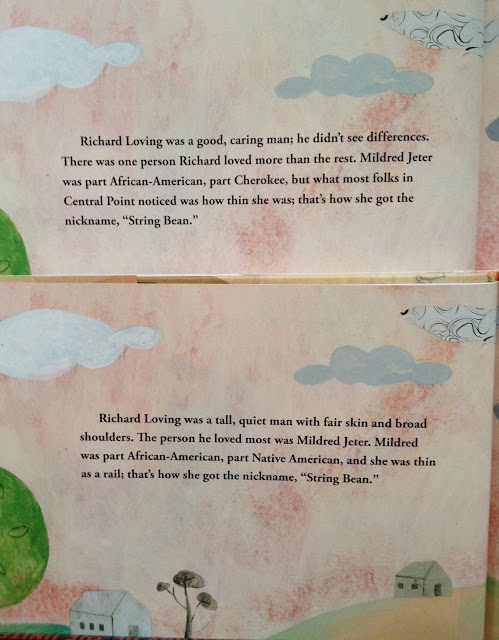 |
| Reese's photo of original (on top) and revised (on bottom) page in THE CASE FOR LOVING |
For now, I'm going to step away from the video and Quall's remarks in order to compare the original lines on the page with the revised ones:
(1)
Original: Richard Loving was a good, caring man; he didn't see differences.
Revision: Richard Loving was a tall, quiet man with fair skin and broad shoulders.
See that change? "he didn't see differences" is gone. This, I think, is the result of Russell-Brown (of the Times) saying that him not seeing difference was implausible, especially since this book is about race.
(2)
Original: There was one person Richard loved more than the rest.
Revision: The person he loved most was Mildred Jeter.
I don't know what that sentence was changed, and welcome your thoughts on it.
(3)
Original: Mildred Jeter was part African-American, part Cherokee...
Revision: Mildred was part African-American, part Native American...
In my review back in March, I said it was wrong to describe her as being part Cherokee, because on the application for a marriage license (dated May 24, 1958), she stated she was Indian. I assume the change to "Native American" rather than "Indian" was done because the person(s) weighing in on the change thought that "Indian" was pejorative. It can be, depending on how it is used, but I use it in the name of my site and it is used by national associations, too, like the National Congress of American Indians or the National Indian Education Association or the American Indian Library Association.
I think it would have been better to use Indian--and nothing else--because that is what Jeter used. "Native American" didn't come into use until the 1970s, as indicated at the Bureau of Indian Affairs website and other sources I checked. In order to tell this story as determined by the Supreme Court case, Alko and Qualls had to include "part African American" because that is the basis on which the case went to the Supreme Court in the first place. I'll say more about all of this below.
(4)
Original: ...but what most folks in Central Point noticed was how thin she was;
Revision: ...and she was thin as a rail;
I think this change is similar to (1). People do notice race.
(5)
Original: ...that's how she got the nickname, "String Bean."
Revision: ...that's how she got the nickname, "String Bean."
No change there, which is fine.
~~~~~~~~~
Now I want to return to the video, and look more closely at (3) -- how Alko and Qualls describe Jeter.
After reading aloud the original and revised passage, Qualls paused. The moderator, Susannah Richards, stepped in. Here's a transcript:
Richards: "Research is complicated, and in researching this particular book, and looking... And even having some of my law friends look at it, they were like 'well some things say she was Cherokee and some things say she was wasn't, some things say her birth certificate said this,' and... There was just a lot of information out there."
Qualls: "Right. And I think that Deborah..."
Richards: "Debbie Reese."
Qualls: "Debbie Reese..."
Richards: "Who many of you may follow on her blog."
Qualls: "Really brought issue with the Cherokee description of Mildred, and, I have spoken to at least some family members and no one really seems to know whether she was Cherokee or Rappahannock. And I think there are some... Debbie Reese may have said, or somewhere I read, that Mildred claimed not to have any African American heritage. But then I've also read that the Rappahannock Nation is less likely to recognize someone as Rappahannock if they claim to have any African American heritage. We're also talking about the 1950s and 1960s where it may have been convenient for someone to claim that they had no African American heritage. James Brown, of all people, claimed he was part Japanese, part Native American, and had no African American heritage. So, it is extremely loaded, and yeah, you know, I really don't know what to say about it. And, it comes down to ones intention, and you know, in trying to represent diversity, and the fact is, no one really knows what her back ground was. I believe that she was part African American. My gut tells me that. She looks that way, she feels that way when I see her, when I see videos of her. So, yeah, that became a little bit of a controversy and was very disturbing to my wife, who is Canadian in origin, and the fact that you're Australian, you know, its very interesting. There are two people that I know that include and have always included African Americans in their art, and without question, that's really important, I think.
Qualls is right, of course. I did raise a question about them identifying Jeter as Cherokee.
I'm curious about his next comment, that he has spoken to family members who say that no one really knows whether she was Cherokee or Rappahannock. In my review, I quoted Coleman's 2004 interview of Jeter, in which she said "I am not Black. I have no Black ancestry. I am Indian-Rappahannock." I didn't include this passage (below) but am including it now--not as a deliberate attempt to argue with Qualls--but because I am committed to helping people understand Native nationhood and how Native people speak of their identity. Coleman writes (p. 173):
The American Indian identity is strong within the Loving family as demonstrated by Mildred’s grandson, Marc Fortune, the son of her daughter Peggy Loving Fortune. When Mildred Loving’s son, Donald, died unexpectedly on August 31, 2000, Marc, according to one attendee, arrived at his uncle’s funeral dressed in native regalia and performed a “traditional Rappahannock” ritual in honor of his deceased uncle. In fact, all of the Loving children are identified as Indian on their marriage licenses. During an interview on April 10, 2011, Peggy Loving stated that she is “full Indian.” This was also the testimony of her uncle, Lewis Jeter, Mildred’s brother who stated during an interview on July, 20, 2011, that the family was Indian and not Black. Echoing his sister’s words he stated, “We have no Black ancestry that I know of.”Based on all I've read and many conversations with people who do not understand the significance of saying you're a member or citizen of a specific tribe, here's what I think is going on.
In watching videos of Jeter, Qualls said that he believes Jeter was part African American. In the video, he said "She looks that way, she feels that way when I see her, when I see videos of her." He is basing that, I believe, on her physical appearance rather than on her own words about her citizenship in the Rappahannock Nation. Qualls is conflating a racial identity with a political one.
I'm not critical of Qualls for thinking that way. I think most Americans would think and say the same thing he did. That is because Native Nationhood is not taught in schools. It should be, and it should be part of children's books, too, because our membership or citizenship in our nations is a fact of who we are. Indeed, it is the most significant characteristic of who we are, collectively. It is why our ancestors made treaties with leaders of other nations. It is why we, today, have jurisdiction of our homelands.
All across the U.S., there are peoples of varying physical appearance who are citizens of a Native nation. My paternal grandfather is white. He was not a tribal member. My dad and my uncle are tribal members. Myself and my siblings, though we range in appearance (I have the darkest hair and skin tone amongst us), are all tribal members. On the federal census, we say we're tribal members and we specify our nation as Nambe Pueblo. Our political identity is a Native one. Because of our grandfather, some of us look like we're mixed bloods, because we are, but when asked, we say we are tribal members, and we say that, too, on the U.S. census documents. We were raised at Nambe and we participate in a range of tribally-specific activities, from ceremonies to civic functions such as community work days and elections. What we look like, physically, is not important.
In short, the revision regarding Jeter's identity is based on a physical description rather than a political one. My speculation: the author, illustrator, and their editor do not know enough about Native nationhood to understand why that distinction matters.
Now let's take a look at the content of the reviews.
The reviewers at School Library Journal, Kirkus echoed the book, saying that Mildred was African American and Cherokee. The reviewer at Publisher's Weekly did not say anything about her identity. Horn Book's reviewer said "Richard Loving (white) and Mildred Jeter (black) fell in love and married..." Not surprisingly, then, that the Horn Book reviewer tagged it with "African Americans" as a subject, and not Native American, but I'm curious why they ignored her Native identity? Did they choose to view the Loving case as one about interracial marriage between a White man and Black woman--as the Loving's lawyers did? Perhaps.
In Older's video, he says that there are some stories that he wouldn't touch. I think the Loving case is one that is more complicated than a picture book for young children can do justice to. Here's key points, from my point of view:
In the 1950s, Mildred Jeter said she was Indian. We don't know if she said that out of a desire to avoid being discriminated against, or if she said that because she was already living her life as one in which she firmly identified as being Indian. Either way, it is what she said about who she was on the application for a marriage license.
In the 1960s, because Mildred Jeter and Richard Loving's marriage violated miscegenation laws, their case went before the Supreme Court of the United States. To most effectively present their case, the emphasis was on her being Black.
In the 2000s, Jeter and her children said they are Indian, and specified Rappahannock as their nation.
In the 2000s, Alko and Qualls met and fell in love.
In the 2010s, Alko and Qualls worked together on a picture book about the Lovings. In the author's note for The Case for Loving, Alko said that she's a white Jewish woman from Canada, and that Sean is an African American man from New Jersey. She said that much of her work is about inclusion and diversity and that it is difficult for her to imagine that just decades ago, couples like theirs were told by their governments, that their love was not lawful. For years, Alko writes, she and Qualls had thought about illustrating a book together. The Case for Loving is that book.
I think it is fair to say that the love they have for each other was a key factor in the work they did on The Case for Loving, but who they are is not who the Lovings were. That fact meant they could not--and can not--see Mildred for who she is.
My husband and I are also a couple in an interracial marriage. He's White; I'm Native. If we were an author/illustrator couple working in children's books and wanted to do a story about the Lovings, we'd enter it from a different place of knowing. We both know the importance of Native nationhood and the significance of Nambe's status as a sovereign nation. He didn't know much about Native people until he started teaching at Santa Fe Indian School, where we met in 1988 when I started teaching there. What we do not have is a lived experience or knowledge of the life of Mildred Jeter as she lived her life in the 1950s in Virginia. We'd be doing a lot of research in order to do justice to who she was.
At the end of his remarks (in the video) about The Case for Loving, Qualls said that it comes down to intentions, and that his wife and Sophie Blackall are very careful to include diversity in their work. He said he thinks it is important. I don't think anyone would disagree with that statement. Diversity is important. But, as his other remarks indicate, he's since learned how complicated the discussion of Jeter's identity were, then and now, too. They've revised that page in the book but as you may surmise, I think the revision is still a problem.
I like the art very much and think it is important for young children to know about the Lovings and families in which the parents are of two different demographics. I'll give some thought to how it could be revised so that it sets the record straight, and I welcome your thoughts (and do always let me know--as usual--about typos or parts of what I've said that lack clarity or are confusing).
Pick up a copy of That the Blood Stay Pure: African Americans, Native Americans, and the Predicament of Race and Identity in Virginia, published in 2013 by Indiana University Press. Read the chapter on the Lovings, and read Alko and Qualls and see what you think. Can it be revised again? How?



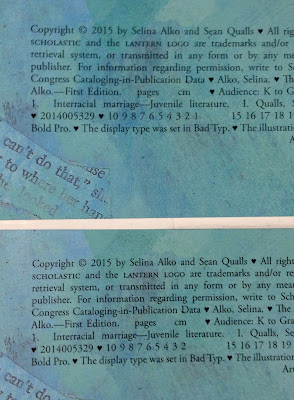
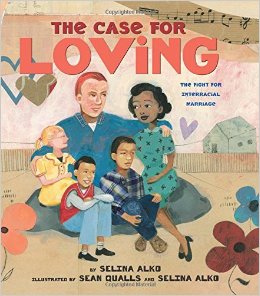
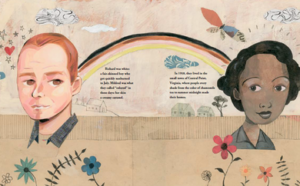
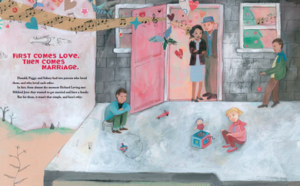


 Here are some literary events to pencil in your calendar. To get your event posted on our calendar, visit our
Here are some literary events to pencil in your calendar. To get your event posted on our calendar, visit our 
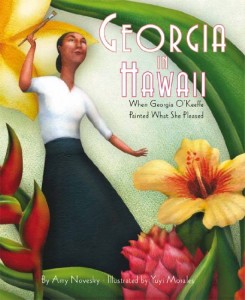
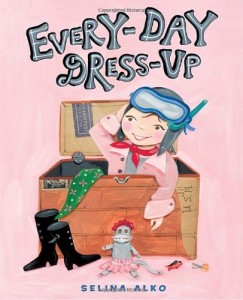
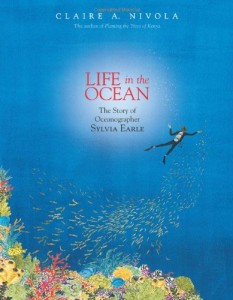


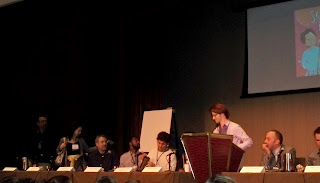
Oh dear, Betsy. How a person chooses to identify who they are is not a “side issue.” Yes, it is a very complicated discussion for a picture book to take on, but at the very least, the book should not say she was part Cherokee, thereby giving incorrect information to the millions of young children, parents, librarians, and teachers who will read this book.
For those interested in knowing more about Jeter’s identity, please visit my post about it:
http://americanindiansinchildrensliterature.blogspot.com/2015/03/the-case-for-loving-by-selina-alko-and.html
Posting again, Betsy, because I think you are–inadvertently–doing that thing where Native concerns are dismissed because the larger message of a book is more important. Doing that, in effect, further marginalizes an already marginalized population.
Your post is especially troubling in light of conversations going on right now about Native identity–Cherokee identity, in particular. The conversation was prompted by an article in the Daily Beast about Andrea Smith’s claims to Cherokee identity. Smith has been a key figure in Native and Women’s studies for a long time. Day in and day out, the Cherokee people are misused and misrepresented. Jeter didn’t do that, and it is wrong to let someone misrepresent her, in 2015.
Identity matters.
Oops! Posted a response to you on Facebook then saw that you’d commented here. Doubling back.
Well it’s something I struggled with certainly. Having read your piece on the book I wanted to understand why the statement that Jeter was multiracial was inappropriate. I’m still trying to understand it, to be frank. From your piece I see that she was multiracial and identified as Native and that the ACLU preferred to portray her as mostly African-American. Yet in the book itself, she is never identified as primarily black. It does put the case in the context of the segregated south and, as you pointed out, the laws regarding interracial marriages between Native Americans and Anglo-Americans were different from those between African Americans and whites. That said, she was partially African-American and so the laws did apply to her. If that is incorrect let me know, since obviously I haven’t studied up on this to the extent that you have. The book is concentrating primarily on the court case and not Jeter’s life, so when I called it a “side issue” I didn’t meant to imply that race itself is a side issue but that in the context of the story being told for children I didn’t see Alko obscuring race in her telling of the court incident. Interested to hear your opinion on the matter.
Identity matters and this is a hot topic not just in the field of race but in gender identity as well. And perhaps I’m not the best person to speak to the subject of race identity. If someone is multiracial but embraces only one race as their identity, is it incorrect then to mention the parts of their identity that they do not ascribe to in their personal life? What did Ms. Jeter say about how she was presented to the media and the courts? Clearly that’s what this all boils down to on some level. At the very least, the issue is complicated.
Good morning, Betsy, and thank you for what you’ve said in your response.
Here’s what uploaded at my site this morning in a post titled “Claiming, Misrepresenting, and Ignorance of Cherokee Identity.” In my next comment, I’ll respond to some points you raised (above) that are not addressed in my blog post.
Some books that we give to young children carry enormous weight. The Case for Loving: The Fight for Interracial Marriage is one example. It is about the Supreme Court’s decision in 1967, in which they ruled that people could marry whomever they loved, regardless of race.
Richard Loving was white. The woman he loved…. is misrepresented in The Case for Loving. The author, Selina Alko, echoed misrepresentations of who Jeter was when she wrote that Jeter was “part Cherokee.”
Jeter didn’t say that she was part Cherokee.
Indeed, her marriage license says “Indian” and when she elaborated elsewhere, she said Rappahannock. I wrote about this at length back in March of 2015.
Yesterday morning (July 2, 2015), I read Betsy Bird’s review of Alko’s book. This part brought me up short:
A side issue has arisen concerning Mildred’s identification as Native American and whether or not the original case made more of her African-American roots because it would build a stronger case in court. This is a far bigger issue than a picture book could hope to encompass, though I would be interested in a middle grade or young adult nonfiction book on the topic that went into the subject in a little more depth.
Actually, saying that it “brought me up short” doesn’t adequately describe what I felt.
First, I knew that Betsy was referencing my post. I took her use of “side issue” as being dismissive of me, and by extension, Arica Coleman (who I cite extensively), and by further extension, Native people who speak up about how we are represented–and misrepresented–in society, and in children’s books. On one hand, I felt angry at Betsy. As a teacher, though, I understand that we’re all on a continuum of knowing about subjects that are outside our particular realm of expertise.
Representation, and misrepresentation, of Native identity is important.
Because so many make that (fraudulent) claim, it strikes me as a significant wrong to see, in The Case of Loving, words that say Jeter was Cherokee when she did not say she was. It unwittingly casts her over in that land in which people claim an identity that is not really theirs to claim.
Here’s another reason that Betsy’s review (posted on July 2, 2015) bothered me. I read it within a specific moment in my work as a Native woman and scholar who is part of a Native community of scholars.
On July 30, 2015 (two days before Betsy’s review was posted), The Daily Beast ran a story about Andrea Smith, a key figure to many academics and activist who are committed to social justice, especially for women, and in particular, women of color. The focus of the article is Andrea Smith’s identity. For years, she claimed to be Cherokee. She said she was Cherokee. But, she wasn’t. She is amongst the millions of people who think that they have Cherokee ancestry. Some do, some don’t.
I met Andy several years ago (most people know her as Andy). At the time, she said she was Cherokee. I had no reason not to believe her. I don’t remember when I first heard that she might not be Cherokee, but I did learn (not sure when) that she had been asked by the Cherokee Nation to stop claiming that she is Cherokee. I don’t know what she personally did after that, and she has not said anything (to my knowledge) since the story appeared in The Daily Beast.
Things being said about Andy, about being Cherokee, and about claims to being Cherokee, reminded me of David Arnold’s Mosquitoland. There’s so much ignorance about being Cherokee! That ignorance was front and center in Arnold’s book. I’m deeply appreciative that he responded to my questions about it, and that he is talking with others about it, too. Those conversations are so important!
I view Andy’s failure to address her claim to Cherokee identity as a dismissal of the sovereignty of the Cherokee Nation. It is a dismissal of their nationhood and their right to determine who their citizens are. Andy knows what the stakes are for Native Nations, and for our sovereignty. She knows what she is doing.
Jeter was adamant about who she was. My guess is that she knew what the stakes were, for her personally, and for the Rappahannock who, as of this writing, are not yet federally recognized as a Native Nation.
Betsy doesn’t have the knowledge that Andy has. Few people do. Betsy is listening, though, as evidenced by her response to me this morning (see her comment on July 3). I am grateful to her for that response. She has far more readers than I do, and our conversation there will increase what people know, overall.
In that response, Betsy notes that Alko probably didn’t have the sources necessary to get it right. Let’s say ok to that suggestion, but, let’s also expect that the next printing of the book will get that part right, and let’s hope that editors in other publishing houses are talking to each other about this particular book and that they won’t be releasing books with that error.
That error may not matter to a non-Native child or her parents, but it matters to a Cherokee child and her parents. It matters to a Rappahannock child and her parents. It should matter to all of us, and it will (I say with optimism and perhaps naively, too), because we’re having these conversations.
By having them, I hope (again, optimistically and perhaps, naively), that we’ll move to a point in time when the majority of the American population will understands what it means to claim a Cherokee (or Native) identity, and a population that ceases to misrepresent Cherokee culture and history. In short, we’ll have a population that is no longer ignorant about Cherokee people specifically, and Native people, broadly speaking. Children’s books are part of getting us there. They carry a lot of weight.
For now, I’ll hit upload on this post, post the link in a comment to Betsy’s review, and respond (there) to other things Betsy said. I hope you’ll follow along there.
The other thing I wanted to comment on, Betsy, is the part about choosing a Native identity when ones identity is a combination of more than one.
For many reasons–including government boarding schools–Native people from a range of nations were in school together. Some fell in love and got married. Such was the case with me. My parents are from two different pueblos (Nambe, and, Ohkay Owingeh). If we look at biology, we’d say that I am a mix of two different groups. Which one am I? In my case, my mom went to Nambe, was subsequently listed on our tribal census, and as each one of us were born (I have 4 younger sibs), our names were added to the tribal census at Nambe. I say that I am tribally enrolled at Nambe. I’m not tribally enrolled at Ohkay Owingeh. I have lots and lots of cousins there, and I go there, but the nation I an enrolled with is Nambe.
My family lineage is not just Pueblo, though. Let’s say I took after (in appearance), my paternal grandfather. He was white, from Texas. If I looked like him, someone might look at me and speculate that I am racist against white people and in denial of my white American heritage. My answer? When I was a kid, I knew to say or write Nambe when asked to at school. I was proud of that identity as a cultural piece of who I was. As I grew older, I knew that my name on that tribal census meant more than just the cultural aspects of what it means to be raised there. It has a political aspect, too, that has to do with our status as a federally recognized sovereign nation. For a very long time, the Rappahannock’s have been trying to become one of the federally recognized tribal nations. My speculation about Jeter and her firm assertion that she was Rappahannock is rooted in my own experience. It doesn’t matter what you look like, or how mixed you might be in terms of biology. What you’re raised as, and your citizenship in that nation, is what matters culturally, but politically, too.
I think the Rappahannock may be on the cusp of being recognized. Just yesterday, news broke that another Virginia tribe, the Pamunkey, gained that status. Here’s one news story about it: http://indiancountrytodaymedianetwork.com/2015/07/02/doi-issues-determination-pamunkey-becomes-no-567-first-federally-recognized-tribe-va
All that said, I will also note that Native peoples can be racist towards African Americans. Here’s a quote from the Washington Post story on Pamunkey recognition: “Members of Congress, including five Democratic congresswomen and members of the Congressional Black Caucus, had also opposed the Pamunkey bid, claiming that the tribe once had rules that discriminated based on race and gender. The tribe said it abandoned those practices long ago.” Arica Coleman discusses this in her book (cited in my initial post), THAT THE BLOOD STAY PURE.
Should any of this be in THE CASE FOR LOVING is a judgement call. I think some kids/families wouldn’t have trouble with it at all, and others would. I agree that we need more books about the Loving case, and as we’ve both said, we need a lot of conversations about all of this. There’s a lot to know.